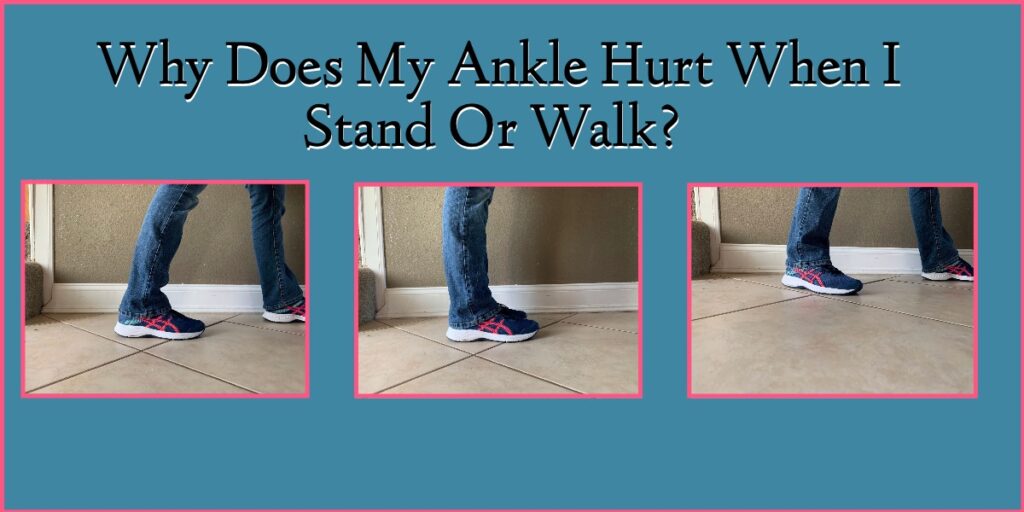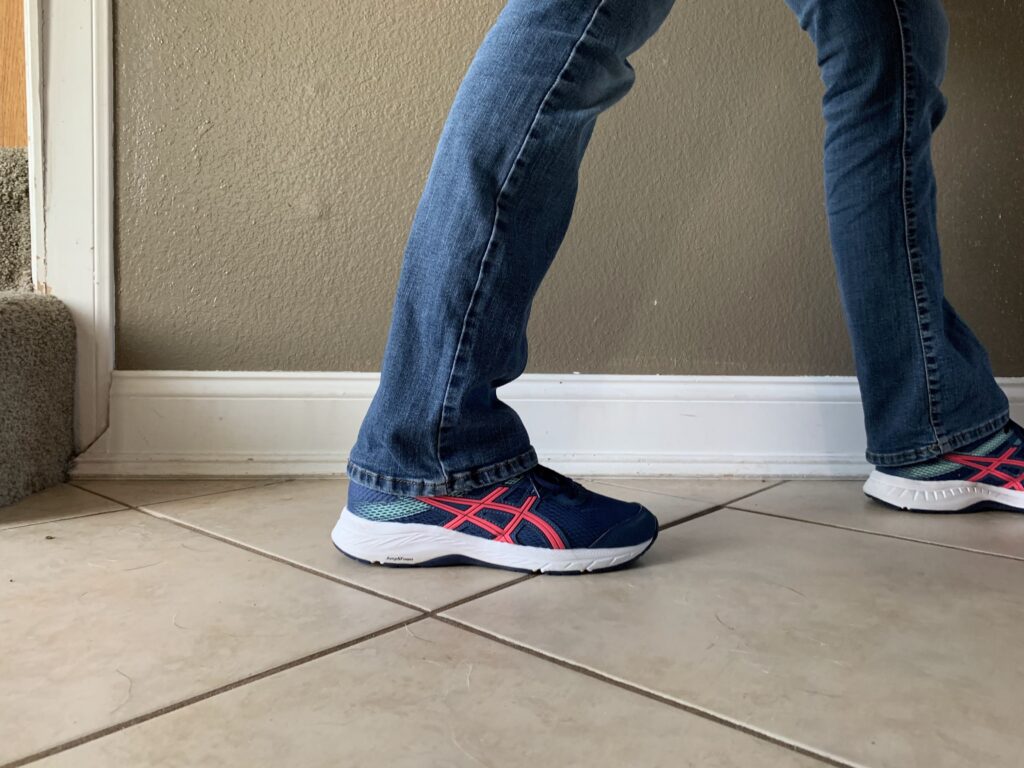
Hi, I’m Dr. Molly with Your Goals Physical Therapy. In this video I wanna go over the question that I got during an evaluation, which was why does my foot hurt when I walk and when I stand? This question was posed to me by a young woman who had gone to the doctor several months ago. Then because of the news that she got during that doctor’s visit, hadn’t really wanted to go and do anything else. She’s been suffering from this ankle pain for six months, close to a year by the time she made it to me.
In this video, I’m gonna go over her story. 1. What she told me when she came in and how she ended up getting into my clinic, (2) go over ankle anatomy with you, a brief overview. (3) Then what is happening with her now? How is she doing?
This young lady told me that maybe eight months ago, she wasn’t really specific. She started getting like this little nagging pain in the back of her heel. She didn’t really think too much of it because at the end of the day it would be a little annoyed. She sat, she rested, everything was fine. Fast forward a few weeks that is progressively getting worse. Now she’s having to alter the shoes that she wears.
She had to alter how she does her workouts, which was very disappointing because she was like, “I stopped running and I stopped going to the aerobic classes I liked and I tried the bike and it still hurt my ankle. She was like, so there went my workouts and that was fine because you know, that’s one less thing on my plate, but now I’m not able to do laundry or dishes. I can’t stand to cook. I can’t drive for long periods of time. Anytime I go to stand up it hurts. She was like, sure, I gave up working out, which was more of a luxury so to speak, but now it’s affecting everything else. So what is going on?”
I asked her, if she went to the regular doctor? Did she go to see her primary care for this? She says yes. “They did an x-ray, but when they suggested that if it didn’t get better, I would need to go to the orthopedic surgeon or somebody else. I freaked out because I didn’t think what I had, needed to have surgery. And so I didn’t know what I was supposed to do with that piece of information.”
“Because that was the only option that they really gave me. I have been neglecting this until I found something of yours on Facebook and I decided I would reach out.” I was like, oh wow. Okay, well that makes sense.
She’s like, “but at this point I’m like so freaked out because every morning I wake up, I put my foot on the floor and it feels like somebody is slicing my foot open. I just don’t know what this means and it’s causing a whole lot of anxiety. I’m very afraid that something very bad is wrong with my foot. I don’t know if it’s ever gonna get better. I don’t know if I’m gonna be dealing with this forever. I like working out. I like going shopping with my friends. I like being able to go to the park and ride bikes with my kids and right now I can’t do any of those things, I can barely manage to cook. So I’m just very nervous as to what you’re gonna tell me today.”
That was basically how we started the eval. I was able to look at her foot and we moved things around and bent things and stretched things and all sorts of craziness, just kidding, but I looked at her ankle. I watched how she walked and I was able to look at things in her hip, her knee, her ankle, just to see how everything was working together and to see where the problem was. As I suspected, she had strained her calf muscle.
That is a muscle that runs from the back of your knee and actually it attaches underneath your heel. But a lot of times you’ll have that pain. If you do have a strain and that pain will be anywhere along, what people think of is that they’re Achilles. So like really close to the heel bone or even just above it. That’s where most people get it and it is worse in the morning. It does somewhat respond to ice, but because you’re constantly stressing it out, typically the ice only helps temporarily.
Again, the calf runs from the back of your knee all the way underneath your heel. A lot of people have heard of plantar fasciitis. That is because there’s fascia on the bottom of your foot, that’s supposed to help with the structure. There’s a big correlation. They work very closely together with your Achilles. A lot of people pronate, right? So if you over-pronate and you have a tendency to have a very flexible foot, it allows your calf to get very stiff because it doesn’t have to be as flexible.
I’m gonna have some pictures of this up to go along with this, because it’s a little confusing without visualizing. But basically if your calf muscle doesn’t have the appropriate length to allow you to walk, the range of motion, then you’re constantly irritating it. It’s like being in a split and being told you have to go a little bit further every day. It wears down that poor muscle and it causes it to spasm, it causes it to develop inflammation. Eventually you’ll get something called tendonitis or tendinosis because it’s just overworked, purely from the limited range of motion or limited length.

I was able to show her on her own foot, what was happening, she could see it. She realized that it was mechanical and that this was something that we could completely fix. When she left the evaluation, you could almost visibly see the weight come off of her shoulders. She even sent me a message a few days later saying how much better she already felt just understanding what was going on and that there was a plan going forward.
Fast forward a couple weeks, she had really good range of motion in her ankle. She was feeling so much better. She started back doing things, she was able to do all of her household chores. She was able to stand all the way through her day. She was able to stand up and sit down without having pain.
As we continued to work a few more weeks, we got her strong enough that she’s back at her gym routine. She doesn’t even have to do the bike, she’s back to running and she’s back to her aerobics classes that she’s so much enjoyed. So in just a few months, we went from completely just barely making it through her day. Just barely making it through the minimum things that you have to do to run a house, back to running.
She is so much happier and she doesn’t have to worry about what’s going on with her body. She doesn’t have to feel like she’s trapped or that she’s older than she is and that this is just how life is gonna be from now on.
If this is the type of care that you’re looking for, I offer two ways to get ahold of my clinic. First I offer a way to schedule a phone call. Sometimes it’s hard to find time to call a clinic. So we’ll call you. If you fill out this form, it just makes it easier, easier for us to contact you, at times that are appropriate. You know some people are busy at different times, so we have blocks of time that we suggest that you fill out.
Secondly, some people would prefer to come and meet in person. I’m also more than willing to do that. I offer free discovery visits. Now there are limited numbers of those. I can only save so many spaces per month for these free visits, but I do find that there is a huge value in people being able to come in and meet me. We talk for 20 minutes. Maybe we do a little bit of a movement assessment just to make sure that I can really do what I’m telling you I can do and make sure that you’re comfortable with that before we move forward.
Those are kind of the two big offers that I’m offering right now. Pick whichever one works best for you. And I hope to speak to you soon. Bye!
Rolling Your Ankle While In An Aerobic Class?
Do I Walk Like A Duck?
Will Plantar Fasciitis Just Go Away?
Why Does My Foot Hurt In The Morning?
Are you unsure if physical therapy is right for you? Or maybe you would like to try our services before making a decision? All you have to do is fill out the simple form above.
If you’re not quite ready to book an appointment yet, you might have some questions you would like answered first. Click above to request to speak with a PT first.
MEDICAL DISCLAIMER:
All information on this website is intended for instruction and informational purposes only. The authors are not responsible for any harm or injury that may result. Significant injury risk is possible if you do not follow due diligence and seek suitable professional advice about your injury. No guarantees of specific results are expressly made or implied on this website.